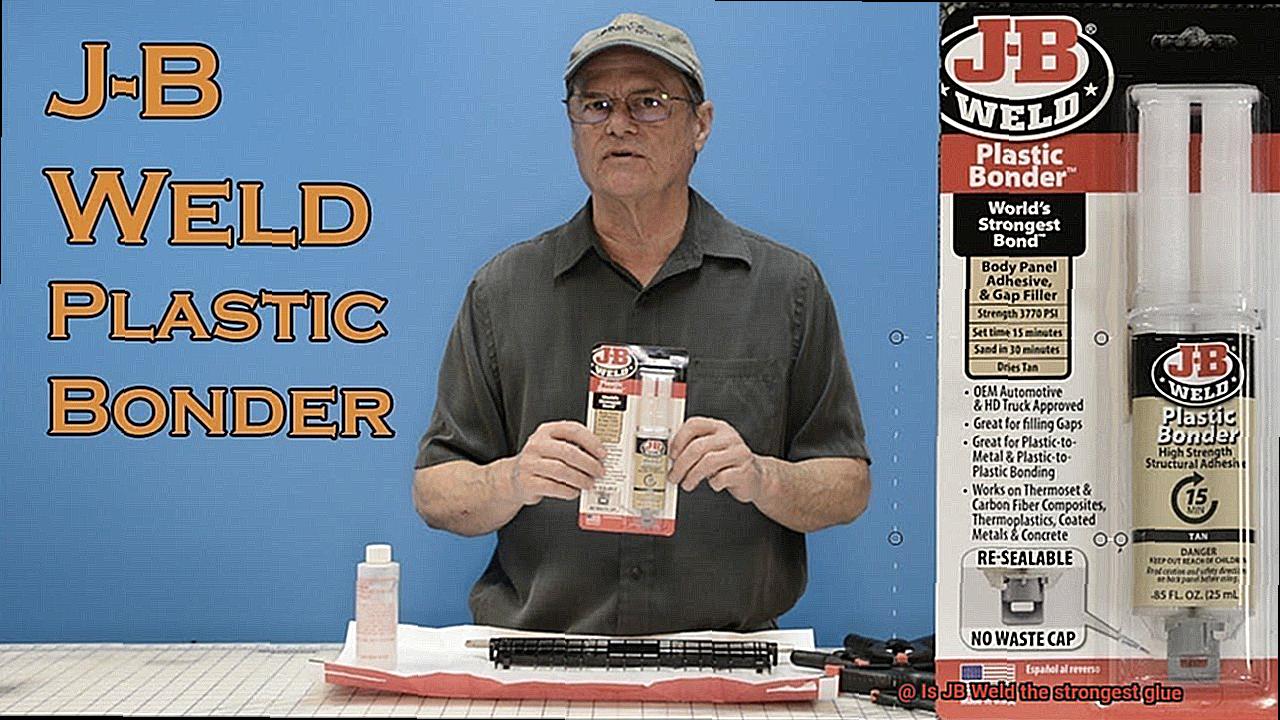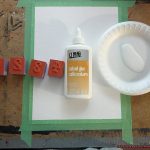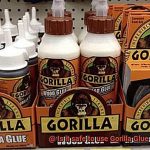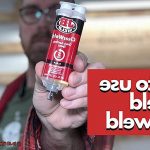Imagine a glue that can conquer any challenge thrown its way, leaving other adhesives in the dust. Well, look no further than JB Weld – the name that echoes through the DIY community and professional circles alike. This isn’t your run-of-the-mill glue; it’s an industrial-grade powerhouse that can withstand even the harshest conditions.
JB Weld is like the superhero of adhesives, armed with a two-part epoxy formula that can bond just about anything together with Herculean strength. Whether you’re tackling a small home project or taking on a massive repair job, this mighty adhesive has proven time and time again that it’s in a league of its own.
So, buckle up as we embark on a thrilling journey into the world of JB Weld. We’ll uncover its mind-boggling capabilities and witness firsthand how it defies expectations in both everyday life and high-stakes industrial applications. Get ready to have your mind blown by this adhesive marvel – even skeptics won’t be able to resist its undeniable allure.
What is JB Weld?
Contents
- 1 What is JB Weld?
- 2 What Materials Can JB Weld Bond?
- 3 How Does JB Weld Compare to Other Glues?
- 4 What are the Advantages of Using JB Weld?
- 4.1 Advantage 1: Unleash the Strength
- 4.2 Advantage 2: Versatility at Its Finest
- 4.3 Advantage 3: Heat Resistance that Outlasts the Inferno
- 4.4 Advantage 4: Chemical Warriors
- 4.5 Advantage 5: Easy Application for Everyone
- 4.6 Advantage 6: The Durability You Can Trust
- 4.7 Advantage 7: Affordable Reliability
- 5 What is the Maximum Temperature That JB Weld Can Withstand?
- 6 How Should You Prepare the Surface Before Applying JB Weld?
- 7 How Should You Apply and Cure JB Weld?
- 8 Are There Any Alternatives to JB Weld that Offer Equally Strong Bonds?
- 9 Conclusion
When it comes to bonding materials together, you need an adhesive that can stand the test of time. Look no further than JB Weld, a two-part epoxy adhesive that has earned a reputation for its exceptional strength and durability. Whether you’re a professional or a DIY enthusiast, JB Weld is the go-to choice for tackling automotive repairs, plumbing fixes, or household projects. In this comprehensive overview, we’ll explore what sets JB Weld apart from other glues on the market and why it continues to be a top choice for bonding various materials.
Unleashing the Power of JB Weld:
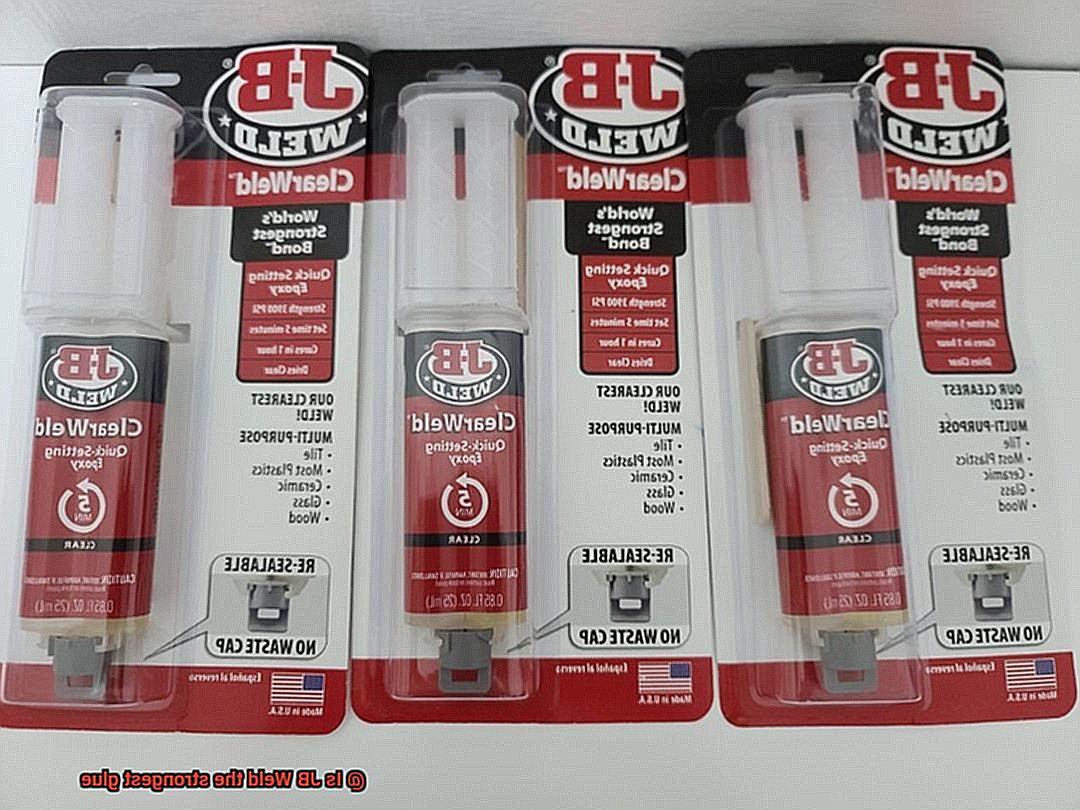
- A Chemical Reaction: JB Weld’s secret lies in its two-part composition—a resin and a hardener. When these components are mixed together, they undergo a powerful chemical reaction that forms an unbreakable bond. This reaction creates a durable and permanent connection between the materials being joined.
- Unmatched Versatility: JB Weld’s versatility is truly remarkable. It can bond an impressive range of materials, including metal, wood, plastic, ceramic, and more. This makes it an ideal option for countless applications around the house, in the garage, or even in industrial settings. No matter the project, JB Weld has got you covered.
- Exceptional Strength: JB Weld isn’t just strong—it’s exceptionally strong. Tested under various scenarios, this adhesive has demonstrated tensile strengths of up to 5,000 pounds per square inch (psi). That kind of power means you can trust JB Weld to handle heavy-duty tasks with ease. Whether you’re repairing a broken metal part or reinforcing a load-bearing structure, JB Weld will hold it together like nothing else.
- Durability in Harsh Environments: JB Weld doesn’t shy away from challenges. It is resistant to chemicals, water, and petroleum-based products, ensuring its integrity in even the harshest environments. Whether you’re fixing a leaky pipe or working on an outdoor project exposed to the elements, JB Weld will remain strong and reliable.
- Seamless Integration: Once cured, JB Weld can be sanded and painted to blend seamlessly with the surrounding materials. This allows for a polished finish, making it difficult to discern where the repair or bond was made. Your projects will not only be structurally sound but aesthetically pleasing as well.
Is JB Weld the Strongest Glue?
While JB Weld is often hailed as one of the strongest glues available, it’s important to consider that different adhesives have varying strengths and suitability for specific applications. Other high-strength adhesives, such as construction adhesives or specialized epoxies, may offer comparable or even superior strength in certain scenarios. It is crucial to evaluate your project requirements and consult with professionals when necessary to determine the most appropriate adhesive for your specific needs.
What Materials Can JB Weld Bond?
When it comes to bonding materials, JB Weld is a force to be reckoned with. This two-part epoxy adhesive has earned a reputation for its exceptional strength and versatility. From metals to plastics, wood to ceramics, and even fiberglass and concrete, JB Weld has the power to create bonds that withstand the test of time. In this comprehensive guide, we will delve into the world of materials that JB Weld can bond, exploring its vast applications and highlighting its remarkable capabilities.
Metals:
JB Weld is a master of metal bonding. It confidently tackles steel, iron, aluminum, brass, bronze, copper, and more. Whether you need to repair a cracked engine block or mend a broken metal tool, JB Weld provides a steadfast solution. Its bond is so strong that it can withstand extreme temperatures and intense pressure.
Plastics:
JB Weld’s prowess extends to various types of plastics. ABS plastic, PVC pipe, fiberglass-reinforced polyester, polycarbonate—you name it, JB Weld can bond it. It effortlessly repairs plastic parts or joins plastic components together, creating a bond that endures under stress and resists chemicals and solvents.
Wood:
Woodworking projects are no match for JB Weld. It skillfully bonds wooden surfaces together, making it ideal for repairing furniture or sealing gaps in wooden structures. With JB Weld, your wooden pieces will stay firmly in place, ensuring lasting durability.
Ceramics and Porcelain:
Imagine being able to restore your cherished ceramic dish or porcelain vase instead of throwing them away. With JB Weld’s reliable bond, shattered ceramic or porcelain objects can be brought back to life. By delicately joining the broken pieces together, JB Weld allows you to cherish these precious items once again.
Fiberglass and Concrete:
For those working with fiberglass or concrete, JB Weld is a trusted companion. It expertly repairs cracks in fiberglass boats or swimming pools, bonds concrete blocks together, and resurrects broken concrete statues. The bond it creates is unyielding, ensuring the structural integrity of your repaired objects.
How Does JB Weld Compare to Other Glues?
Look no further than JB Weld, the ultimate adhesive that outshines its competitors in terms of bond strength, versatility, and resistance to different environments and substances.
First and foremost, let’s talk about bond strength. When it comes to creating an unbreakable bond, JB Weld is in a league of its own. It can withstand high temperatures, pressure, and vibrations without losing its grip. Whether you’re fixing a leaky pipe or repairing a metal surface, JB Weld will provide a secure and long-lasting bond that won’t let you down.
But it’s not just about strength – versatility is another key advantage of JB Weld. While some other glues are limited to specific materials or applications, JB Weld can be used on a wide range of surfaces and materials. From metal to wood, plastics to ceramics, and everything in between, this adhesive has got you covered. It’s the go-to choice for DIY enthusiasts and professionals alike.
And when it comes to resistance, JB Weld shines again. It can withstand exposure to water, chemicals, oils, and even extreme weather conditions without deteriorating or losing its bond. This means you can trust JB Weld for both indoor and outdoor applications, knowing that it will hold up against the elements.
Of course, it’s important to note that while JB Weld is a top-notch adhesive, there may be specific glue formulations that are better suited for certain applications. For example, if you need an adhesive with flexibility or fast curing time, there may be other options that are more suitable.
What are the Advantages of Using JB Weld?
When it comes to finding a reliable adhesive, look no further than JB Weld. This powerhouse adhesive offers a plethora of advantages that make it a go-to choice for both professionals and DIY enthusiasts. From exceptional strength and versatility to heat and chemical resistance, JB Weld is the ultimate bonding solution that can tackle any repair or bonding project with ease.
Advantage 1: Unleash the Strength
JB Weld boasts an impressive tensile strength of up to 5020 PSI, making it one of the strongest adhesives available in the market. Whether you need to mend a broken metal tool or bond together different materials like wood, plastic, or ceramic, JB Weld’s high strength ensures a durable and long-lasting bond that can withstand even the toughest conditions.
Advantage 2: Versatility at Its Finest
No matter the surface or material, JB Weld fearlessly tackles any challenge thrown its way. From metal to wood, plastic to ceramic, this adhesive is a true jack-of-all-trades. So whether you’re fixing a leaky pipe or repairing a broken household item, JB Weld has got you covered.
Advantage 3: Heat Resistance that Outlasts the Inferno
JB Weld isn’t afraid of a little heat. With the ability to withstand temperatures up to 550 degrees Fahrenheit (287 degrees Celsius), this adhesive is perfect for repairs on automotive engines, exhaust systems, or industrial machinery. Say goodbye to worries about your repairs melting under extreme heat.
Advantage 4: Chemical Warriors
JB Weld not only stands strong against heat but also offers excellent resistance against various chemicals. It can handle exposure to automotive fluids, gasoline, oil, water, and other solvents without losing its bonding strength. So whether you’re working on an automotive project or dealing with harsh substances, JB Weld will keep your bond intact.
Advantage 5: Easy Application for Everyone
Despite its exceptional strength, JB Weld is surprisingly easy to use. Its two-part epoxy system requires mixing before application, but don’t worry – it’s a breeze. Just combine the components in equal proportions and apply directly to the surfaces needing to be bonded. The adhesive gives you enough working time for perfect positioning and adjustments, making your repair process stress-free.
Advantage 6: The Durability You Can Trust
Once properly applied and cured, JB Weld creates a bond that can withstand vibrations, impacts, and external forces. This durability ensures that your repairs will last for an extended period, giving you peace of mind knowing that your fix is reliable and long-lasting.
Advantage 7: Affordable Reliability
You might think that an adhesive with such exceptional qualities would burn a hole in your pocket, but not JB Weld. This adhesive is surprisingly affordable compared to other high-strength options on the market. So whether you’re a professional technician or a DIY enthusiast, JB Weld offers a cost-effective solution without compromising on quality.
What is the Maximum Temperature That JB Weld Can Withstand?
JB Weld, a popular epoxy adhesive known for its strength and durability, is a reliable choice for high-temperature applications. When fully cured, JB Weld can withstand a maximum temperature of 550 degrees Fahrenheit (287 degrees Celsius), making it suitable for a wide range of projects. However, it’s important to note that the maximum temperature resistance may vary depending on the specific formulation of JB Weld.
For those working with extreme heat conditions, there is a specialized variant called JB Weld ExtremeHeat. This formula is designed to handle temperatures up to a remarkable 2,400 degrees Fahrenheit (1,315 degrees Celsius), making it ideal for demanding applications like automotive exhaust systems or industrial machinery.
While JB Weld can withstand high temperatures, it’s vital to consider the duration of exposure to heat. Prolonged exposure to extreme temperatures can still impact the adhesive’s performance, even if it has a high temperature resistance.
To ensure optimal results and the longevity of the bond, always follow the manufacturer’s instructions and guidelines when using JB Weld or any other adhesive. This includes properly preparing the surfaces before application, allowing sufficient curing time, and avoiding excessive heat exposure if not specified by the product.
How Should You Prepare the Surface Before Applying JB Weld?
However, achieving a strong and long-lasting bond requires proper surface preparation. In this comprehensive guide, we will walk you through the essential steps to prepare the surface before applying JB Weld, ensuring a successful project every time.
Step 1: Clean the Surface
Before applying JB Weld, it is crucial to remove any dirt, dust, grease, or other contaminants that could hinder adhesion. Start by using a degreaser or mild detergent to thoroughly clean the surface. Rinse it with water and allow it to dry completely before proceeding. This step ensures maximum contact between the adhesive and the surface for a strong bond.
Step 2: Roughen the Surface
Roughening the surface enhances the bond strength by providing more surface area for JB Weld to adhere to. Use sandpaper or a wire brush to create a rough texture on the surface. This step is particularly important when working with smooth or non-porous materials like metal or plastic. By roughening the surface, you create tiny nooks and crannies where the adhesive can securely grip.
Step 3: Remove Loose Particles
After roughening the surface, remove any loose particles or debris created during the process. Gently brush away the loose material using compressed air or a clean brush. This step ensures that there are no loose particles that could interfere with the bonding process. A clean and debris-free surface allows for optimal adhesion and a seamless bond.
Step 4: Consider Acid Etching (if applicable)
In some cases, especially when working with metals, using an acid etching solution can further enhance adhesion. Acid etching creates microscopic channels on the surface, allowing JB Weld to penetrate and bond more effectively. Follow the manufacturer’s instructions carefully and take proper safety precautions when using an acid etching solution. This step is particularly useful when working with smooth or non-porous metals, ensuring a strong and durable bond.
Step 5: Temperature and Humidity Considerations
Before applying JB Weld, consider the temperature and humidity conditions in which you are working. Ideally, the temperature should be between 50°F and 90°F (10°C and 32°C) for optimal curing. High humidity can affect curing time, so ensure that you are working in a well-ventilated area with moderate humidity levels. These considerations will ensure that the adhesive cures properly and forms a solid bond.
Step 6: Applying JB Weld
Once the surface is prepared and all necessary precautions have been taken, it is time to apply JB Weld. Follow the instructions provided by the manufacturer, as different formulas may have specific application techniques. Mix equal parts of the epoxy resin and hardener thoroughly before applying it to the prepared surface. Apply the adhesive evenly and avoid excessive application to prevent any excess from interfering with the bond.
How Should You Apply and Cure JB Weld?
Today, we delve into the world of JB Weld, the transformative adhesive that can turn your projects from ordinary to extraordinary. In this comprehensive guide, we unveil the secrets to applying and curing JB Weld correctly, unlocking a bond so strong it feels like wielding the power of a thousand suns.
Step 1: Prepare for Success
Before embarking on the application process, meticulous surface preparation is key. Cleanliness reigns supreme. Ensure that the areas to be bonded are free from grease, oil, rust, or paint. Utilize a degreaser or alcohol-based cleaner to wipe away impurities. For optimal adhesion, gently sand the surfaces if needed.
Step 2: Mix Like a Pro
Once your surfaces are pristine, it’s time to unleash your inner chemist. Remember, JB Weld consists of two components – epoxy resin and hardener. Measure equal parts of these components and mix them thoroughly on a disposable surface like cardboard or plastic. Grab a wooden stick or plastic spatula and blend until you achieve a consistent color and texture.
Step 3: Apply with Confidence
The moment has come to harness the mighty power of JB Weld. Armed with a brush or spatula, generously apply the adhesive onto the prepared surfaces. Leave no area untouched – complete coverage guarantees an unbreakable bond. Let your confidence shine through as you wield JB Weld like a master craftsman.
Step 4: Patience is Key
Having applied JB Weld, it’s time for a test of patience. Allow a minimum of 24 hours for the adhesive to cure fully. Bear in mind that temperature and humidity can affect curing time, so ensure optimal conditions for an unparalleled bond.
Step 5: Keep It Steady
During the curing process, stability is paramount. Avoid any movement or stress that could compromise the bond. Employ clamps or other steadfast methods to secure the parts until JB Weld achieves its maximum strength, typically after approximately 72 hours of curing.
Step 6: Handle with Care
While JB Weld can withstand extreme temperatures once fully cured, handle freshly applied adhesive with caution. Treat it gently until it has reached its maximum strength, ensuring nothing hinders the magnificent bond you’ve created.
Step 7: Finishing Touches
After JB Weld has fully cured, you may encounter excess or visible residue. Fear not. Simply eliminate any unwanted remnants by sanding or scraping as necessary. Prioritize safety by using appropriate tools and taking necessary precautions to achieve a flawless finish.
Are There Any Alternatives to JB Weld that Offer Equally Strong Bonds?
JB Weld has long been a trusted adhesive for creating strong bonds, but if you’re searching for alternatives that offer equally robust adhesion, there are several options worth exploring. In this article, we will delve into these alternatives, highlighting their strengths and the specific applications they excel in.
Epoxy Putty:
Epoxy putty is a two-component adhesive consisting of a resin and a hardener. Renowned for its exceptional bonding capabilities across various materials – metal, wood, ceramic, and plastic – epoxy putty is both incredibly strong and heat-resistant. Its durability makes it ideal for applications where long-lasting adhesion is essential.
Polyurethane Adhesive:
Polyurethane adhesive is another versatile alternative to JB Weld that offers outstanding bonding strength. It bonds different materials such as metals, plastics, and wood with exceptional durability. What sets polyurethane adhesives apart is their ability to withstand water and chemicals, making them perfect for projects in damp or harsh environments.
Structural Adhesives:
Structural adhesives encompass a range of options, including Acrylic Adhesives and Cyanoacrylate (Super Glue). Acrylic adhesives are known for their impact resistance and ability to withstand temperature fluctuations, while cyanoacrylate adhesives offer instant bonding and are perfect for small repairs or projects requiring swift results.
Specialized Adhesives:
For specific applications, specialized adhesives may be the best choice. Automotive Epoxy Adhesives are designed to endure extreme conditions commonly encountered in automotive repairs. Metal Bonding Adhesives are formulated specifically for bonding metals under intense stress, providing exceptional strength.
H4xX7VecgzA” >
Conclusion
JB Weld is often touted as one of the strongest glues on the market. Its reputation for strength and durability has made it a go-to option for many DIY enthusiasts and professionals alike. But is it truly the strongest glue out there?
To answer that question, we need to consider what makes a glue strong. Strength can be defined in various ways – it could refer to the adhesive’s ability to bond different materials together, its resistance to heat and moisture, or its overall holding power.
When it comes to bonding capabilities, JB Weld certainly holds its own. It is designed to create a strong bond between various surfaces, including metal, wood, plastic, and more. This versatility makes it an attractive choice for a wide range of projects.
In terms of resistance to heat and moisture, JB Weld also excels. It can withstand high temperatures up to 550 degrees Fahrenheit (288 degrees Celsius), making it suitable for applications where other adhesives might fail. Additionally, it is resistant to water and chemicals, ensuring that your bonded surfaces stay intact even in harsh conditions.
But what about holding power? JB Weld boasts impressive tensile strength and can provide a secure hold even under heavy loads. However, it’s important to note that there are other glues on the market with similar or even greater holding power.
Ultimately, determining the “strongest” glue depends on your specific needs and requirements. While JB Weld offers exceptional strength in many aspects, there may be instances where another adhesive better suits your project.
In conclusion, while JB Weld is undoubtedly a formidable adhesive with remarkable bonding capabilities and resilience against heat and moisture, claiming it as the absolute strongest glue would be subjective.

